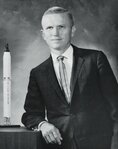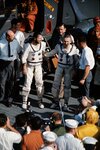Wind: mph,
Welcome to our new web site!
To give our readers a chance to experience all that our new website has to offer, we have made all content freely avaiable, through October 1, 2018.
During this time, print and digital subscribers will not need to log in to view our stories or e-editions.



Apollo 8 astronaut, U.S. Air Force colonel, aeronautical engineer and one-time Las Cruces business owner Frank Borman died Nov. 7 in Billings, Montana at age 95.
Borman and his wife, Susan, moved to Las Cruces and Borman became majority owner of a Las Cruces Ford dealership founded by his son, Fred, in 1986. Borman was actively involved in helping restructure the business and hiring a professional management team. It went on to become one of the largest dealerships in the region, both by acreage and total sales volume.
Borman purchased a cattle ranch in southern Montana in 1998.
In 2006, Borman also donated part of a hangar he owned at Las Cruces International Airport so the Experimental Aircraft Association Chapter 555 of Las Cruces could have its own hangar.
Borman was born in Gary, Indiana, and grew up in Tucson, Arizona, where he graduated from high school. He was a 1950 graduate of West Point military academy and was a USAF test pilot until he moved to Houston in 1962 to become a NASA astronaut.
He was on the 1965 Gemini 7 flight with Jim Lovell.
Borman was part of the December 1968 Apollo 8 crew (along with Lovell and William Anders) that were the first humans to leave low earth oribit and among the first three astronauts to see and photograph the far side of the moon and to an earthrise.
Borman retired from NASA and USAF in 1970 and later was president and chief operating officer of Eastern Air Lines. He retired from Eastern in 1986 when he moved to Las Cruces.
Borman was inducted into the International Space Hall of Fame at the New Mexico Museum of Space History in Alamogordo in 1982.
About his seeing the moon closer than anyone ever had to that point, Borman said, “It was a sobering sight, but it didn't have the impact on me, at least, as the view of the Earth did. When you’re finally up at the moon looking back on earth, all those differences and nationalistic traits are pretty well going to blend, and you’re going to get a concept that maybe this really is one world and why the hell can’t we learn to live together like decent people.”
Some information for this report contributed by the New Mexico Museum of Space History in Alamogordo.